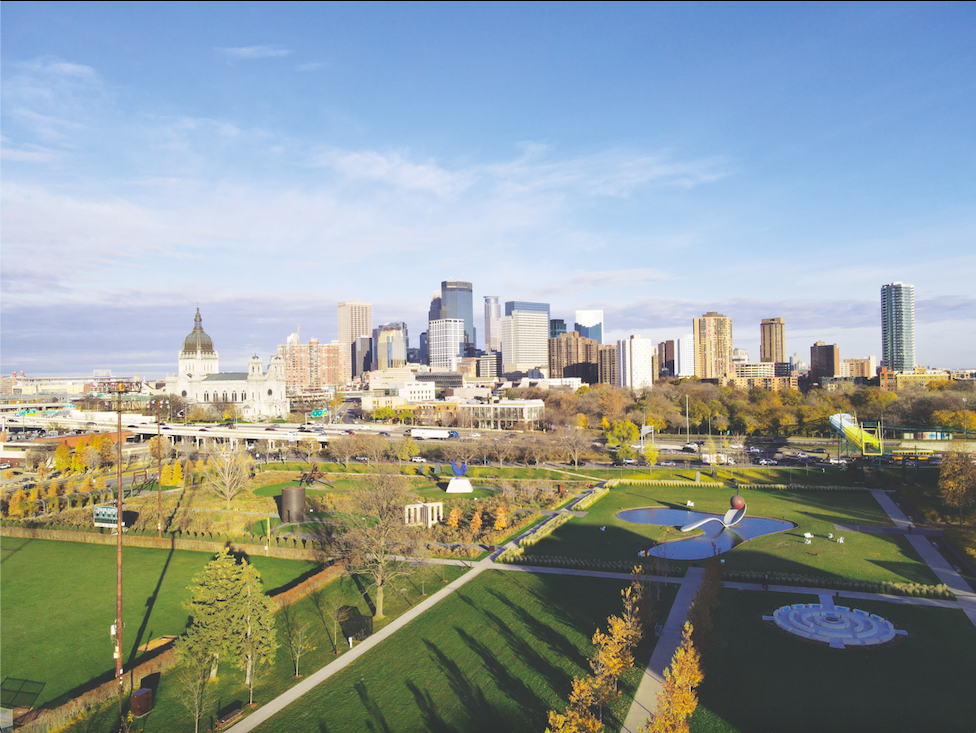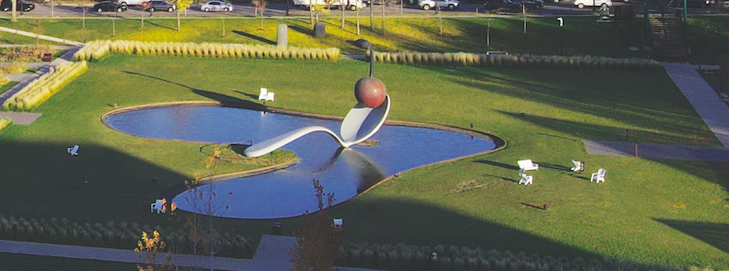Explore Minneapolis
Exposing student body to unfamiliar aspects of Upper School's city
December 6, 2021

Local Markets Offer Variety, Fresh Produce
MPLS farmers’ markets attract over two million Minneapolitans
The pungent yet sweet aroma of a spice you just can’t put your finger on or the countless specialized food trucks you can’t decide between; farmers’ markets provide a service and experience nothing else can quite replicate. In Minneapolis, there is no shortage of farmers’ markets; the city boasts more than 20 within the metro area and all are visited by more than two million people annually. What’s more, each farmers’ market provides a diverse set of options, so no matter what you desire, there is probably something for you.
You can’t go wrong with the most popular market in Minneapolis: The Minneapolis Farmers’ Market on Lyndale, located on 312 East Lyndale Avenue, which is open all year. Founded in 1876, it is the oldest as well. The main reason for its popularity is the market’s unparalleled variety of prepared food. With 100 vendors who use 170 different stalls, the farmers’ market on Lyndale has more than enough to offer including produce, eggs, and meat. Additionally, it’s easily accessible, with plentiful and free parking.
The Mill City Farmers’ Market, located on 714 South 2nd Street on Saturdays, and 425 Portland Avenue South on Tuesday nights. The market was founded in 2006, and features a plethora of food vendors. What separates the Mill City Farmers’ Market from the others is its proximity to downtown Minneapolis, which means that although parking may be tough, there are many music, sporting and other activities around. The closeness to downtown al- lows for opportunities that no other market can replicate. The market also offers free cooking classes from professional chefs. In the winter, it is open on select Saturdays.
In addition to these markets, there are many more that are open either exclusively in the sum- mer or year-round with indoor winter options. For example, If you are interested in more of a family- oriented market, Kingfield Farmers’ Market or Fulton Farmers’ Market would be the best option.
The Midtown Global Market is an exclusively indoor non-traditional market that offers a market atmosphere. If you are interested in a smaller or more intimate market, the Lin- den Hills Farmers’ Market is open Sunday mornings, and the Nokomis Farmers’ Market is open Wednesday nights.

Museums Provide New Outlooks, Perspectives
Local art curation changes to include more diverse pieces
Home to some of the most prized pieces of art in the world, the backdrop of a multitude of movies and the Met Gala every May, museums traffic in hundreds of millions of tourists every year. D.C, Rome, Paris, New York; when reflecting on cities with exciting exhibits our parents attempt to entice us to visit on the next family trip or convince us of where we should spend a random summer day, Minneapolis may not come to mind. Yet, with its rich industrial history and diverse roots, its museums offer a look into some of the most unique and interesting experiences all within a short car trip or walk away.
Toby Weiland ‘23, a member of the Martha Bennett Gallery Curatorial Team, believes that museums have value because they bring differing groups of people together, tying together their differing perspectives. He notes, “Everybody ends up looking at the same art piece but you can get so many different stories, perspectives, and viewpoints from each different person and I really like that. Everyone can look at the same thing and have so many different ideas.” Bill Colburn ‘88, the curatorial team’s advisor, adds that “The beauty of the museum is that [they] force all of us to think about things in new ways. One of the things that I recently heard from, it’s actually the author of the book we’re reading in Art History… she said in humanity we [are] all swimming in a pool and doing our day-to-day getting through, and artists show us the wall… You’re forced to think about who you are and where you’re going and what you’re doing, if you slow down and take your time so I think it’s absolutely fantastic.”
Minneapolis offers a wide range of museums that provide these very experiences such as the Walker, the Minneapolis Institute of Art (Mia), the Weisman Museum, and the Mill City Museum. Specifically, Weiland states, “I’ve found I really like the Mia. I think they’ve got a lot of good shows, I spend a fair amount of time there. And it’s not necessarily a museum but I’ve found the Minnesota Historical Society has a lot of really really cool things so I like to spend my time there.”
Museum closures have been a challenge for business and the art world as with anything during the pandemic, but Colburn notes a surprisingly beneficial side, “Yes a lot of people stopped going, a lot of people started do- ing things online right away.” He furthers that now, many museums offer artist talks online, that he otherwise could not attend. Specific to Minneapolis he notes, “The Walker now is closed Monday, Tuesday, Wednesday, and it’s open Thursday, Friday, Saturday, Sunday and I’m not sure when they’re going to open Tuesday and Wednesday they were never open on Monday… there are always a lot of people there and so I kind of feel right now for whatever reason, the museum is being used more so that’s good.”
Colburn notes another large shift within art museums and the broader art world: the art world has progressed to change their permanent galleries in order to expand the voices included, get broader perspectives and increase diversity. The term for this work is called “deaccessioning,” and it’s not only happening throughout the world but in the Twin Cities as well. Colburn states, “When you go to the sculpture garden right now it is like any where you look you can see a sculpture by a woman but if you do a count, because we do this in my Art History class, if you do a count it’s like one to three, one female sculpture for every three male sculptures. So, it’s like they’re not there yet but they’re working on it.”
Additionally he ex- plains that there are different ways to go about implementing more diversity into one’s gallery besides deaccessioning, the Walker and Guthrie Theater in Minneapolis have found a mutually beneficial way to do this. “If you go to the Guthrie, there’s that hill next to the Guthrie, it’s called Gold Medal Park… [which] now has three super cool sculptures; they used to be pivotal sculptures in the Sculpture Garden.”

Restaurants Diversify Food Culture, Delight
Food variety around city provides endless options
Minneapolis contains many great restaurants that are definitely worth giving a try. Here are some of my favorite Minneapolis restaurants (not in any particular order):
Naviya’s Thai Brasserie is an amazing Thai restaurant, located on West 43rd Street. It offers great in-house food and takeout that is equally delicious. Personally, this is one of my favorite Thai restaurants––and even a favorite restaurant in general. Naviya’s has a delicious variety of dishes, my favorites including the pineapple fried rice, chicken satay, cashew chicken, pad thai, and tofu spring rolls. I love Naviya’s because it has unique and authentic flavors that are strong, spicy, and simply tasty.
Common Roots Café is another great restaurant that I definitely recommend. It is located on Lyndale Ave South, close to the Northrop Campus, serving locally-sourced and organic foods from their kitchen or bakery with a variety of gluten free and vegan options available. This cafe is casual and amazing to eat outside on their patio on a hot summer day. The patio is very nice and has plenty of outdoor seating. It’s a great place to stop by for a quick, and yummy meal. Some of my favorites include the wild rice burger, and the wild rice apple salad.
Martina, a modern, upscale Argentine-Italian restaurant located on Upton Ave South, is also a delicious brunch and dinner spot. I always love the food that I order here and it is so wonder every time. Some of my favorite dinner dishes include cacio e pepe agnolotti, potato gnocchi, charred cucumbers, potato churros, avocado bruschetta, and the charred brussel sprout salad. Martina also has many sister restaurants in Minneapolis: Rosalia, Colita, Sanjusan, Cardamom, and Café Ceres, all featuring various foods from around the world.
Black Sheep Pizza is a delicious pizza place on Washington Avenue North. If you are a fan of wood-fired pizza, you will love this tasty, flavorful option. I would recommend getting the house salad, and the “#9” pizza, which is fresh tomatoes, green peppers, and kalamata olives. For people who enjoy meat on their pizzas, they have a wide variety of mixed meat pizzas. I could never get sick of eating at this restaurant, and it is one of my all time favorites. Black Sheep is a great place to order to-go, and to eat in-person.
Christos Greek Restaurant is a restaurant, located on Nicollet Avenue, serving Greek and widely Mediterranean-style dishes. It is very filling, and the food feels very authentic. Some of my favorites to order are the chicken kebab, pita and falafel. Christos has very good gyros as well. As much as I like Christos, out of all of the restaurants listed, I would recommend the others before this.
My final recommendation is World Street Kitchen on Lyndale Avenue South. It’s open from 11 a.m. to 10 p.m. and has takeout and eat in. The hummus and pita, caramelized brussel sprouts, hummus bowls, and sweet onion stuffed falafel “burger” are very good. It is a casual, tasty restaurant right next to Milkjam Creamery, a nationally-known ice cream shop, and a great place to try for a dessert. in, great for a hot summer day. WSK started as a food truck by two brothers named Sameh and Saed Wadim, and has now expanded to a popular restaurant. This restaurant is definitely worth giving a try.

Iconic City Landmark Temporarily Relocates
The “Spoonbridge and Cherry” sculpture marks one of Minneapolis’ most recognizable features. However, on Nov. 16 the cherry portion of the sculpture was removed and began transport to New York to be refinished.
The sculpture requires refinishing after around 10-12 years of wear-and-tear, in order to maintain its color and finish. The firm in New York, Fine Art Finishes, specializes in this sculpture type, having previously refinished the “Spoon- bridge and Cherry” 10 years ago and upkeeping the sculptor duo Claes Olden- burg and Coosje van Bruggen’s (creators of the “Spoonbridge and Cherry”) other pieces.
Because the cherry is such a large piece, it is difficult to repaint, and previous touch-ups had not been as thorough when it was still attached to the spoonbridge. So, the Walker Arts Center decided to send the sculpture portion to a company that can thoroughly repaint the sculpture to last another decade.
The sculpture is set to return to the Twin Cities in mid-January.